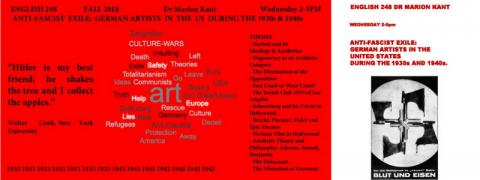Anti-fascist exile in the English-speaking world: German artists in the United States during the 1930s and 1940s
“Hitler is my best friend; he shakes the tree and I collect the apples.”[1] Walter Cook at New York University said in the early 1930s. We often assume that the writers, composers and artists who were hounded by the Nazis could easily leave Germany and were welcomed with open arms in other countries. Some of the most famous artists’ names of the 20th century can be found on the lists of refugees. When they went into exile, they took with them their rich experiences of artistic creation but also a profound concept of ‘culture’ and a deep conviction that the arts mattered. Acceptance and integration into the English-speaking world was not easy, in fact, it was much more difficult than they had anticipated. Most refugees remained nameless, lost in an incomprehensible environment and rejected by the majority of the population of the US. What happened to the aesthetic concepts that the German, mainly German-Jewish refugees brought with them? What happened to Bertolt Brecht’s vision of a new theatre, what to Fritz Lang’s Weimar film experience, what to Hanns Eisler’s left-wing music, what to the many writers who could not switch to English as their new writing language? Were they accepted and, as Cook claimed, integrated into American society? British writer and poet Christopher Isherwood, close friend of many of the exiles, painted a rather dark picture of their reception in his Diary. This course looks at the reality of fleeing political persecution and the reality of finding and living in exile – as an intellectual, or an artist.
Course Outline:
1. Nazism into Power
2. Ideology, Aesthetics and the Nazi State
3. The Arts as Propaganda - Degeneracy as an Aesthetic Category.
4. The Elimination of the Opposition – Concentration Camp.
5. The Elimination of the Opposition – Exile.
6. East Coast or West Coast? The Jewish Club 1933 of Los Angeles and its Model of Integration.
7. Music, the Most German of the Arts: Schoenberg and his Circle in Hollywood.
8. Dance and Movement: Is Modernism Always Progressive?
9. Brecht, Piscator, Eisler and the Stagnation of Epic Theater.
10. Weimar Film in Hollywood – Fritz Lang, Billy Wilder, Berthold Viertel.
11. Aesthetic Theory and Philosophy in Exile: Walter Benjamin, Theodor W Adorno, Hannah Arendt.
12. The Holocaust.
13. The Liberation of Germany by the Allies – Émigré Concepts for a Democratic Germany.
14. The Denazification of Germany – Re-emigration and the Return of the Arts.
[1] Quoted in Erwin Panofsky, Three Decades of Art History in the United States…, in: Meaning in the Visual Arts. New York: Vintage 1955, p.332.

 Department of English
Department of English
